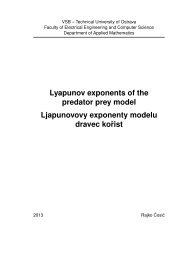The Boundary Element Method for the Helmholtz Equation ... - FEI VÅ B
The Boundary Element Method for the Helmholtz Equation ... - FEI VÅ B
The Boundary Element Method for the Helmholtz Equation ... - FEI VÅ B
Create successful ePaper yourself
Turn your PDF publications into a flip-book with our unique Google optimized e-Paper software.
24 2 <strong>Helmholtz</strong> <strong>Equation</strong>and due to properties of uFor <strong>the</strong> integral I 2 we obtainlim I 1 = 0.ε→0 +I 2 = 1 2π π24π 0 − π 21ε 2 eiκε (1 − iκε)u x + ε(cos ϑ cos ψ, sin ϑ cos ψ, sin ψ) ε 2 cos ψ dψ dϑ= 1 2π π2e iκε (1 − iκε)u x + ε(cos ϑ cos ψ, sin ϑ cos ψ, sin ψ) cos ψ dψ dϑ4π 0 − π 2and using <strong>the</strong> Lebesgue dominated convergence <strong>the</strong>orem and qualities of u we haveFinally, letting ε → 0 + we obtain from (2.8)∆u(y) + κ 2 u(y) v κ (x, y) dylim I 2 = u(x).ε→0 +Ω=∂Ω∂u∂n (y)v κ(x, y) ds y − u(y) ∂v κ(x, y) ds y − u(x).∂Ω ∂n ySince <strong>the</strong> point x ∈ Ω was arbitrary, we have proved <strong>The</strong>orem 2.6.When solving a problem of sound scattering or wave propagation described by <strong>the</strong><strong>Helmholtz</strong> equation we are usually interested in <strong>the</strong> solution in an unbounded domain.<strong>The</strong> following <strong>the</strong>orem gives us <strong>the</strong> representation <strong>for</strong>mula <strong>for</strong> such domains (see [6]).<strong>The</strong>orem 2.7 (Representation Formula <strong>for</strong> Unbounded Domains). Let Ω ⊂ R 3 be abounded C 1 domain, let v κ denote <strong>the</strong> fundamental solution <strong>for</strong> <strong>the</strong> <strong>Helmholtz</strong> equation inR 3 and let n denote <strong>the</strong> unit outward normal vector to ∂Ω. Let us define Ω ext := R 3 \ Ω.<strong>The</strong>n <strong>for</strong> u ∈ C 2 (Ω ext ) satisfying∆u + κ 2 u = 0in Ω extand <strong>the</strong> Sommerfeld radiation condition x ∇u(x), − iκu(x)1∥x∥ = O ∥x∥ 2<strong>for</strong> ∥x∥ → ∞we have <strong>the</strong> representation <strong>for</strong>mulau(x) = u(y) ∂v κ(x, y) ds y −∂n y∂Ω∂Ω∂u∂n (y)v κ(x, y) ds y <strong>for</strong> x ∈ Ω ext .









